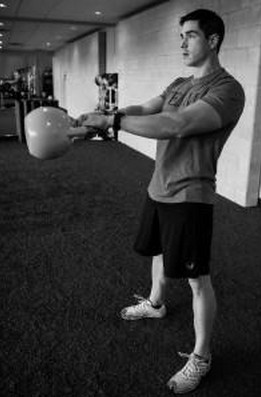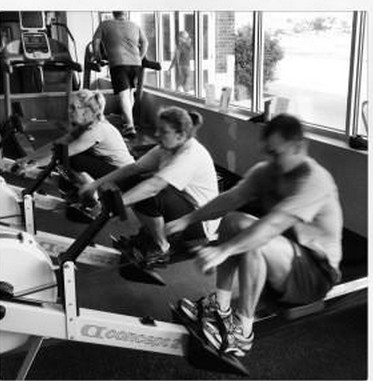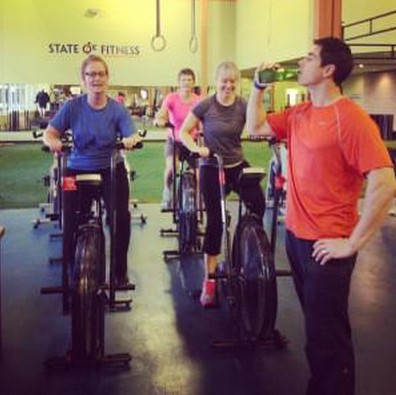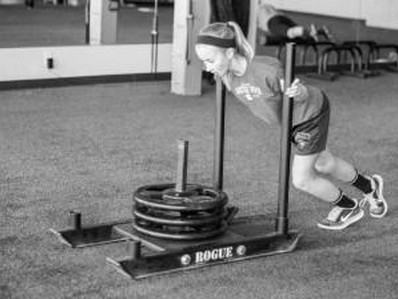Pushtoday
MuscleChemistry Registered Member
by Justin Grinnell
In todays post, I am going to outline the four different protocols of cardiovascular training that we use at State of Fitness, and one that we encourage people to do on their own.

- Metabolic Conditioning
- Moderate Intensity Cardio
- Slow-long distance cardio (active play)
- Interval Training
[h=2]Metabolic Conditioning[/h]The term metabolic conditioning, or “met-con” for short, has been thrown around a lot in the fitness industry in recent years. It can be confusing to understand what it exactly means.
My personal definition is simple. It is a short period of hard work with very minimal rest, while using large muscle groups with each movement. It imposes a metabolic demand that challenges the body both mentally and physically. It can include a variety of modalities, such as interval training, kettlebell, barbell and dumbbell complexes, battling ropes, body weight exercise, plyos, and a combination of all of them.
I have explored some of the “metcon” workouts that Greg Glassman developed. Glassman is the creator of the CrossFit version of “met-con”. Not as much because of the physical affect, but more of the mental challenge affect. Take a look at why CrossFit believes in “metcon” workouts so much. I will say that these types of “metcon” workouts are not for everyone. If you are a beginner, you may want to stay away from some of the CrossFit style “metcon” workouts. If you have no injuries and have some training age under your belt, they can be a good “once in a while” cardio challenge.
Before we go any further, let’s define metabolic conditioning. Metabolic conditioning or “metcon” refers to conditioning exercises intended to increase the storage and delivery of energy for any activity. Most people think of aerobic training to be the primary catalyst when trying to improve endurance, conditioning the cardiovascular system, and to improve transport of blood to the working muscles. Concurrently, metabolic conditioning is conditioning the MUSCLES to better use the fuel delivered to them by improving the efficiency for the different metabolic pathways.
Anaerobic (weight training, sprinting) has now been shown to condition the cardiovascular system more efficient than traditional cardio routines (walking, running long distance) alone.
While I feel metabolic conditioning is the most efficient way to burn fat and improve cardiovascular output, there still are some benefits to interval training and slow long distance or aerobic training (more on this later).
So, let’s look at why “Met Con” has been deemed so much more efficient and effective, when compared to slow long distance cardiovascular exercise.
[h=5]Metabolic Conditioning Bullet Points[/h]
- Combines strength, power, conditioning, and core exercises
- Can implement unilateral, multi-planar, and corrective exercises to further enhance metabolic demands and correct asymmetries and functional movement patterns
- The workouts themselves are MORE effective in terms of client’s results (improved fitness, weight loss, core strength, stability, etc.) than traditional interval training
- Is much more engaging and fun, and has a lot of room for variety
- 1-Arm KB Snatch
- 1-Arm bent Over KB Row
- 1-Arm KB Clean
- 1-Arm KB Push Press
- 1-Arm KB Swing[h=5]CrossFit Triplet Metabolic Conditioning Circuit[/h]This is an example of a 21-15-9 “metcon” workout that is similar to the style that CrossFit trainers will use. You simply combine a weight training exercise, a gymnastic or bodyweight exercise and a metabolic conditioning exercise, and perform them as fast as possible. You will do 21 reps of each exercise, then 15 reps, and then 9 reps.
- Concept 2 Rower (for calories)
- Barbell Thrusters
- Burpees

We use these types of extended circuits to challenge our members and clients at State of Fitness, both mentally and physically. When combining large muscle group movements for high reps, with moderate weight, (say a 10-15 rep max weight), you build up a tremendous amount of lactic acid, thus increasing growth hormone significantly. In the CrossFit world, these are known as “Chippers”.
You will also experience an increased conditioning component that causes your VO2 max to be put into overdrive. Think kicking your cardiovascular systems butt!
[h=5]Perform as many reps as possible (AMRAP) in 20 minutes[/h]- Wall Ball Shots: 30 reps
- Sumo Deadlift High Pulls: 30 reps
- Push Press: 30 reps
- Concept 2 Rower: 30 calories
- Push-ups: 30 reps
- Goblet Hold Walking Lunges: 30 reps
- Pull-ups: 10 reps
[h=2]Moderate Intensity Cardio[/h]To optimally improve your overall aerobic base, you also need some moderate intensity cardio. Here is why. The left ventricle of your heart controls the ease at which you pump blood throughout your body. The stronger you make it, the better it moves your blood and the more oxygen you get through your system – i.e., the better you can exert yourself without getting tired.
You cannot strengthen the left ventricle with HIIT. This is because the intensity level is too high, and your heart beats to fast. You simply cannot sustain the effort long enough to get the training effect you need.
After many years of putting down non-HIIT cardio, I have come to embrace some good old-fashioned moderate intensity cardio. I hate the word “moderate”, but it makes sense for this case. What I mean by moderate intensity, is that you are moving at a pace where you will be increasing your heart rate significantly, breaking a good sweat, and maybe be able to talk to your friend rowing or running next to you. You can use many modalities, such as running, biking, swimming, and stair climbing.
This kind of cardio helps you recover faster between workouts, between sets of high intensity exercise, and even reps.
In order to build an aerobic base, you need to back off on the HIIT and Met Con work, and do a little moderate intensity cardio. I have outlined some of my favorite moderate intensity- aerobic base building workouts for this months workout. At State of Fitness, we prefer to use the Concept 2 Rower and the Airdyne bikes for both HIIT and moderate intensity. You can run and swim, if you choose to.
[h=5]The Workouts[/h]Pick two (2) of these workouts to perform each week. Make sure to track progression to see improvement.
[h=5]Airdyne Bike For Miles[/h]- Bike 3 miles; rest 1 minute
- Bike 2 miles; rest 1 minute
- Bike 1 mile; done!

[h=5]Row Down The River[/h]- Advanced: 5,000 meter (5k)
- Intermediate: 4,000 meters (4k)
- Beginner: 3,000 meters (3k)
[h=5]Airdyne Gone Too Long[/h]- Advanced: 5 miles
- Intermediate: 4 miles
- Advanced: 3 miles
[h=5]Split Up The Row[/h]- Row 2,000 meters (2k); rest 1 minute
- Row 1,000 meters (1k); rest 1 minute
- Row 500 meters at an easy pace; rest 1 minute
- Row 250 meters at an easy pace
[h=5]Max Distance Airdyne[/h]- Bike as far as possible in 20 minutes
[h=5]Max Distance Row[/h]- Row as far as possible in 20 minutes
[h=2]Slow-Long Distance Cardio[/h]This form of cardio is what I consider “active play”. Walking for extended periods of time is a great form of movement. I recommend that people stay active, even on their off-workout days.

Going for a nice long walk or bike ride is the perfect “active play” modality to help improve recovery from more demanding workouts. But, I do not recommend this to slash body fat. Simply put, it just isn’t as efficient and effective as met-con, interval training, and moderate intensity cardio. It is a good starting point for those who are de-conditioned and are just starting out.
But after a while, you need to add some more intense forms of cardio, in order to see improvements in fat loss and conditioning. Let’s take a look at why slow-long distance cardio should not be the cornerstone of your cardiovascular workout routine.
[h=5]Why slow-long distance (walking and running) is less efficient and effective[/h]- Takes a long bout of exercise to burn a significant amount of calories
- Walking is a good start and a great form of active play on an off-workout day, but it won’t burn a significant amount of fat or improve cardiovascular conditioning.
- One mile of running or jogging will burn between 100 to 300 calories based on your weight, age, and other factors. But in order to jog that mile you will subject your joints to 1500 plyometric reps at (consecutively) 2-4-x bodyweight.
- That is a lot of pounding on your joints while increasing your injury potential. The return on investment (100-300 calories burned) is not worth it.
- Doesn’t raise the heart rate and oxygen debt, thus not increasing the metabolic rate after exercise is done (EPOC- Excessive Post-exercise Oxygen Consumption)
- The body adapts to the low intensity exercise to quickly (plateaus)
- The so called “fat burning” zone myth
- Sprinters (4-9% bodyfat) Vs. Runners/walkers (12-25% bodyfat)
- If you are just starting a workout program, injured (walk, don’t run), severely overweight or have other severe health conditions
- If you are training for a half marathon, full marathon, triathlon
- A great form of active play (walking, not jogging) to perform on an off-workout day.
- Recover faster between workouts, between sets of high intensity exercise, and even reps.
[h=2]Interval training[/h]- It is a method of conditioning that uses alternating periods of work and rest.
- Can be done by using various modalities such as an Airdynbike, treadmill, sprinting, Concept 2 Rower, and stepmill.
- A simple method is sprinting for 30 seconds, and then taking a 30-90 second rest break (rest depends on condition of person)
- Number of intervals depends on the goal, and fitness level of the person
- Athletes and fitness enthusiast alike to get in shape for years have utilized interval training. Interval training has even taken on a new name in recent years, High Intensity Interval Training (HIIT).
- Increases the bodies metabolic rate 12-48 hours after exercise is done (EPOC)
- This type of training is not only being used by athletes to improve conditioning, but also by trainers and their clients as one of the best methods for fat loss and conditioning.
- With our busy lifestyles, who has time to do 40-60 minutes of aerobic training? The scientific data now shows less is better when it comes to fat loss!
[h=5]The Power of Interval Training[/h]The way for individuals to raise the intensity of their training is to do “Interval Training.” Interval Training alternates bouts of high-intensity exercise with that of low to moderate-intensity exercise. Recent studies have shown that Interval Training is more effective for fat loss while improving both Aerobic and Anaerobic fitness.
[h=5]If it works why doesn’t everyone utilize HIIT?[/h]- Media has over hyped long bouts of cardiovascular exercise for health
- HIIT is much more physically demanding
- Most people are confused about how to do it and make it work
- Still is a lot of repetitive motion at the ankle, hip, and knee, thus causing muscular imbalances and asymmetries
- Many people don’t like to use machines and get bored to fast. This discourages them from performing interval training
- Interval training is much harder than walking, jogging, or running, in turn discouraging them even more from staying on the same machine for 15-30 minutes

[h=5]Interval Training Workouts[/h]- Perform 5 rounds of 300 meters on the Concept 2 Rower. Rest as long as it takes you to complete each successive 300-meter row in between each interval.
- Perform 6 rounds of 30 seconds on/30 seconds off on the Airdyne bike.
- Tabata – perform 8 rounds of 20 seconds of work, and take 10 seconds of rest between each 20-second interval.
- Sled Push – Load the sled up and push for 30 seconds or around 40 yards for 4-8 rounds. Rest 1-2 minutes between rounds.
Cardio on

